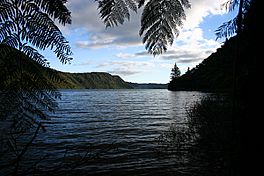Lake Rotokākahi facts for kids
Quick facts for kids Lake RotokākahiGreen Lake |
|
|---|---|
 |
|
| Location | Bay of Plenty, North Island |
| Coordinates | 38°13′S 176°20′E / 38.217°S 176.333°E |
| Type | crater lake |
| Basin countries | New Zealand |
| Max. length | 4.3 km (2.7 mi) |
| Max. width | 1.7 km (1.1 mi) |
| Surface area | 4.5 km2 (1.7 sq mi) |
| Average depth | 17.7 m (58 ft) |
| Max. depth | 32.0 m (105.0 ft) |
| Surface elevation | 394 m (1,293 ft) |
Lake Rotokākahi, also known as Green Lake, is a beautiful lake in the Bay of Plenty region of New Zealand. It's located on the North Island, between Lake Rotorua and Lake Tarawera.
This lake is one of four small lakes in the area. The others are Lake Tikitapu (Blue Lake), Lake Okareka, and Lake Okataina. All these lakes are found within a large volcanic area called the Okataina caldera.
About Green Lake
Lake Rotokākahi gets its name from the Māori word for freshwater mussels, kākahi. These mussels were once very common in the lake.
The lake looks emerald green from above. This is because it has a shallow, sandy bottom. The lake sits 394 metres above sea level. It is also 24 metres lower than its nearby neighbour, Lake Tikitapu.
Water from Lake Rotokākahi flows into Lake Tarawera. It does this through the Te Wairoa waterfalls.
A Sacred Place
Lake Rotokākahi is very special to the Te Arawa iwi (tribe), especially the Tūhourangi people. They consider the lake to be tapu, which means it is sacred or forbidden.
Because it is sacred, the lake remains mostly untouched. This means it is a very important cultural site.
Motutawa Island
Motutawa is a small island located in Lake Rotokākahi. This island has a significant place in New Zealand's history.
In 1822, a group of Ngāpuhi people faced a difficult event here. This led to a response from Hongi Hika in 1823. The island is also known as the resting place for the bones of Hinemoa, a famous figure in Māori legends.
The name Motutawa means "tawa tree island". This name comes from the tawa trees that grow there.



